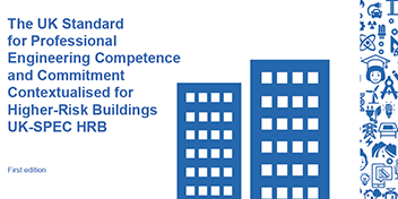The Building Safety Act received Royal Assent and became an Act of Parliament on 28 April 2022. The Act was established to address the need to raise the bar on competence of those working in higher-risk buildings and was welcomed by the Engineering Council.
The Chartered Institution of Building Services Engineers (CIBSE) has published a summary and key implications of the Act.
Alongside this legislation, the Government has asked the Health and Safety Executive (HSE) to establish a new building safety regulator (BSR) to:
- Implement a new, more stringent regulatory regime for high-risk residential buildings
- Promote competence among industry professionals and regulators to raise standards in design, construction, and the management of buildings
- Oversee performance systems of all buildings, so one regulator can provide guidance on building performance as well as building safety, ensuring that factors like countering climate change are factored into regulatory decisions
The government’s proposals were informed by an independent review of building regulations and fire safety, commissioned by the Ministry of Housing, Communities and Local Government (now DLUHC) in the wake of the Grenfell Tower fire on 14 June 2017 which led to 72 fatalities.
The final report from the review, Building a Safer Future, was published on 17 May 2018. The 53 recommendations included specific proposals to raise the bar on the competence of people designing, constructing, and operating High-Risk Buildings (HRBs) throughout the building lifecycle. Key professions identified in the report included engineers and fire engineers.
To meet that challenge, and take forward the report’s recommendations, the Competence Steering Group (CSG) was created in August 2018. The Engineering Council has led a working group (Working Group 1: Engineers, or WG1 Engineers) as part of this initiative.
In August 2019, the CSG published its interim report, Raising the Bar. It included 67 recommendations including creating a suite of national standards and supporting documents.
Recommendation 20 of ‘Raising the bar’ stated:
Industry should lead the creation of an HRB benchmark competence framework covering the core knowledge, skills and behaviours required to work on HRRBs as part of a suite of national standards under the governance of the national standards body against which professional and trade bodies are expected to develop their individual sector-specific or discipline competence frameworks.
On March the 1st 2023 the HSE launched the Be Ready Campaign aimed at helping and encouraging everyone affected by changes to building safety law to:
- Be ready: Understand what is coming and how to prepare
- Step up: Take ownership and manage risks
- Act now: Comply with new law
The third and final report from the CSG is urging companies and individuals to adopt new competence practices and measures for a safer built environment. The report - A Higher Bar - Achieving a Competence-led Built Environment – sets out the significant steps being made across the built environment and fire sectors in improving skills, knowledge, and behaviours to drive culture change and improve the safety of buildings.
New standards, competence frameworks, accreditation procedures and learning materials have been developed by the CSG’s Working Groups and taken forward by the Engineering Council, the BSI and other bodies.
The report also sets out the next steps for the Group as it looks to accelerate the roll out of the new competence requirements and systems across the built environment workforce. The CSG has been instrumental in shaping government policy, including securing the setting up of the Industry Competence Committee within the Building Safety Regulator and making it a requirement within the Building Safety Act for dutyholders to employ competent people.
Going forward, the CSG is to become an independent sub-group of the Building Safety Regulator’s Industry Competence Committee and will be renamed as the Industry Competence Steering Committee (ICSG).
Hard copies can be pre-ordered here.
The Engineering Council is a member of the Built Environment Competence Standards (BECS) Strategy Group and is involved in the development of overarching Built Environment Competence Standards, being led by British Standards Institution (BSI).
BS 8670 Built Environment - Core criteria for building safety in competence frameworks - Code of practice
Following the BSI consultation which closed on 2 February 2021, the third and final version of BSI 8670: v3.0 2021-04, Built environment – Core criteria for building safety in competence frameworks – Code of practice has now been released.
This BSI 8670 is the result of the Advisory Group reaching consensus on the comments received during two public consultations, with those outcomes being adopted into the standard.
The Fire Safety Consultation:
- Seeks to strengthen the Fire Safety Order and improves compliance for all regulated buildings
- Implements the Grenfell Tower Inquiry Phase 1 report recommendations for multi-occupied residential buildings which require a change in the law
- Seeks views on the effectiveness of the arrangements for consultation and information sharing between building control bodies and fire and rescue authorities in relation to building work - alongside an overhaul the Fire Safety Order’s supporting guidance
- The consultation outcome can be found here
The national construction products regulator
As part of wider reforms to address systemic failings identified by the Hackitt Review, the Department for Levelling up Housing & Communities (DLUHC) work to address the culture within the construction industry and the Grenfell Tower Inquiry, it has been announced that the Office for Product Safety and Standards (OPSS) will be the national regulator for construction products.
DLUHC are to retain responsibility for construction products’ policy and OPSS is to operate as a Joint Unit, accountable to DLUHC Ministers for its construction products function.
OPSS and DLUHC will continue to work together to ensure a new legal framework sets appropriate and clear safety obligations on businesses supplying construction products. The scope of construction product regulations will be extended, subject to the appropriate legislation, to cover all products used in building and construction projects, strengthen national and local regulatory enforcement powers and increase national oversight of the whole system.
Dedicated DLUHC funding will support the new functions ensuring existing OPSS activity including product safety, metrology, support for local authorities including Primary Authority, and enforcement functions for other government departments will be protected.
Collaborative Reporting for Safer Structures (CROSS)
CROSS’s roots date back to 1976. It was established to identify, in advance, trends and developments which might contribute to an increased risk to structural safety. The CROSS scheme was first launched in 2005 as an independent system which allows professionals to confidentially share their experiences to help others. It was based on the success of confidential reporting in the aviation sector. CROSS is backed by the Institution of Structural Engineers and the Institution of Civil Engineers.
In response to the dreadful Grenfell Tower fire tragedy, Dame Judith Hackitt, in her Independent Review of Building Regulations and Fire Safety, recommended that CROSS should be expanded and strengthened. With support from the Institution of Fire Engineers and additional Government funding, CROSS relaunched in 2021 and now receives and processes fire safety reports in addition to structural safety reports.
CROSS is a community of professionals who share safety information to allow learning from each other’s experiences. It promotes an open, collaborative, no-blame culture. CROSS welcomes reports about fire safety and structural safety, including issues relating to infrastructure, buildings, and other structures. All reports received are anonymised and then reviewed by Expert Panels. CROSS Expert Panels are made up of leading professionals. They offer their time voluntarily and come from a wide variety of sectors. They use their experience to help readers understand what can be learned from the reports we receive. Reports provide an opportunity to address shortfalls within the industry. They may identify precursors, or trends, indicating a potential future safety issue. They allow CROSS to share lessons learned and improve competency. They may help to inform regulatory change or advance industry guidance. Reports can make a difference and will promote positive cultural change. We want professionals to use the information we publish to help make structures safer and, ultimately, to save lives and reduce injuries.
We encourage all professional engineers working within the development and management of the built environment to visit cross-safety.org and join a community of experts sharing and enhancing their knowledge to help create a safer built environment.
We encourage professional engineers to share any safety concerns they have by submitting a report – the process is quick and simple, and their submission will be anonymised and confidential. More information can be found at https://www.cross-safety.org/uk/submit-a-report-uk.
We encourage professional engineers to read the latest newsletters for examples of the expert safety information shared by CROSS.
Building Safety Regulator (BSR) Webinar Series
Transitioning to the Building Safety Regulator
Since April 6 2024, if your project:
- Had building control arrangements in place, and
- Building work (including design work) had started, and
- A notice that the work had made sufficient progress was not given to the LA by 6 April
Or:
- Has started building work but existing building control arrangements cease /are cancelled, or
- Has started building work but there were no formal building control arrangements in place
Then, your project will need to transfer from your existing building control provider to Building Safety Regulator.
For more information on this, please read here: Eligibility for transitional arrangements in building control - Making Buildings Safer
Publication of the Grenfell Tower Inquiry Phase 2 Report
On Wednesday 4 September 2024, the Inquiry published its final report on the Grenfell Tower disaster.
To read the reports, please read here: Publication of the Grenfell Tower Inquiry phase 2 report.
Government responds in full to Grenfell Tower Inquiry
On 26 February, the government accepted the findings and set out its plans to act on all 58 recommendations.
To read the report, please visit: Grenfell Tower Inquiry Phase 2 Report: Government Response.
Building Safety Alliance
The Building Safety Alliance has produced guidance regarding the Golden Thread. It has been published in three parts, including a master list of documents and other information sources currently used by industry, which can be used to identify the key data which needs to be specified for the golden thread information requirements.
The work builds on the Construction Leadership Council's golden thread guidance released in 2024 and has been undertaken over several years of voluntary effort by an expert panel. This edition of the guidance is aimed at supporting technical people familiar with the legislation and its golden thread requirements. Stakeholders are invited to join the collaboration to adapt this standardised approach to the wider range users and personas in the built environment that need to meet golden thread duties.

UK-SPEC HRB ›
The UK-SPEC HRB is a new Standard from the Engineering Council that sets out the competences and commitments for engineers and technicians on higher-risk buildings.

Our guidance ›
Our guidance will help you on your journey to become professionally registered with the Engineering Council.

Continuing Professional Development (CPD) ›
CPD has several purposes which will vary in relation to your circumstances, needs and career progression.





